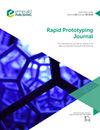Cryogenic tensile performance of 3D printed onyx–continuous carbon fiber composites
IF 3.6
4区 工程技术
Q1 ENGINEERING, MECHANICAL
引用次数: 0
Abstract
Purpose The aerospace, energy and automotive industries have seen wide use of composite materials because of their excellent mechanical properties, along with the benefit of weight reduction savings. As such, the purpose of this study is to provide an understanding of the mechanical performance of these materials under extreme operational conditions characteristic of in-service environments. Design/methodology/approach This study is novel in that it has evaluated the tensile performance and fracture response of additively manufactured continuous carbon fiber embedded in an onyx matrix (i.e. nylon with chopped carbon fiber) at cryogenic and room temperatures, for specimens manufactured with an angle between the specimen lying plane and the working build plane of 0°, 45° and 90°. Findings Research findings reveal enhanced tensile properties (i.e. ultimate tensile strength and modulus of elasticity) by the 0° (X) built specimens, as compared with the 45° (XZ45) and 90° (Z) built specimens at cryogenic temperature. A reduction in ductility is observed at cryogenic temperature for all build orientations. Fractographic analysis reveals the presence of fiber pullout/elongation, pores within the onyx matrix and chopped carbon fiber near fracture zone of the onyx matrix. Research limitations/implications Research findings present tensile properties (i.e. ultimate tensile strength, modulus of elasticity and elongation%) for three-dimensional (3D)-printed onyx with and without reinforcing continuous carbon fiber composites at cryogenic and room temperatures. Reinforcement of continuous carbon fibers and reduction to cryogenic temperatures appears to result, in general, in an increase in the tensile strength and modulus of elasticity, with a reduction in elongation% as compared with the onyx matrix tensile performance reported at room temperature. Fracture analysis reveals continuous carbon fiber pull out for onyx–carbon fiber samples tested at room temperature and cryogenic temperatures, suggesting weak onyx matrix–continuous carbon fiber adhesion. Originality/value To the best of the authors’ knowledge, this study is the first study to report on the cryogenic tensile properties and fracture response exhibited by 3D-printed onyx–continuous carbon fiber composites. Evaluating the viability of common commercial 3D printing techniques in producing composite parts to withstand cryogenic temperatures is of critical import, for aerospace applications.3D打印玛瑙连续碳纤维复合材料的低温拉伸性能
由于复合材料具有优异的机械性能和减轻重量的优点,因此在航空航天、能源和汽车工业中得到了广泛的应用。因此,本研究的目的是了解这些材料在服役环境的极端操作条件下的机械性能。设计/方法/方法本研究的新颖之处在于,它评估了在低温和室温下,在放置面与工作构建面之间的夹角为0°、45°和90°的情况下,嵌入玛瑙基体(即尼龙与短切碳纤维)的增材制造连续碳纤维的拉伸性能和断裂响应。研究结果显示,与45°(XZ45)和90°(Z)构建的低温样品相比,0°(X)构建的样品具有更高的拉伸性能(即极限抗拉强度和弹性模量)。在低温下,所有建筑方向的延展性都有所降低。断口分析表明,玛瑙基体中存在纤维拉拔/伸长现象,玛瑙基体中存在孔隙,玛瑙基体断口附近存在短切碳纤维。研究局限/意义研究结果展示了三维(3D)打印玛瑙在低温和室温下的拉伸性能(即极限抗拉强度、弹性模量和伸长率%),连续碳纤维复合材料有和没有增强。一般来说,连续碳纤维的增强和低温的降低似乎导致抗拉强度和弹性模量的增加,与室温下的玛瑙基体拉伸性能相比,伸长率降低了%。断裂分析显示,在室温和低温下,玛瑙-碳纤维样品的连续碳纤维被拉出,表明玛瑙基质与连续碳纤维的附着力较弱。据作者所知,这项研究是第一个报道3d打印玛瑙连续碳纤维复合材料的低温拉伸性能和断裂响应的研究。对于航空航天应用来说,评估普通商业3D打印技术在生产耐低温复合材料部件方面的可行性至关重要。
本文章由计算机程序翻译,如有差异,请以英文原文为准。
求助全文
约1分钟内获得全文
求助全文
来源期刊

Rapid Prototyping Journal
工程技术-材料科学:综合
CiteScore
8.30
自引率
10.30%
发文量
137
审稿时长
4.6 months
期刊介绍:
Rapid Prototyping Journal concentrates on development in a manufacturing environment but covers applications in other areas, such as medicine and construction. All papers published in this field are scattered over a wide range of international publications, none of which actually specializes in this particular discipline, this journal is a vital resource for anyone involved in additive manufacturing. It draws together important refereed papers on all aspects of AM from distinguished sources all over the world, to give a truly international perspective on this dynamic and exciting area.
-Benchmarking – certification and qualification in AM-
Mass customisation in AM-
Design for AM-
Materials aspects-
Reviews of processes/applications-
CAD and other software aspects-
Enhancement of existing processes-
Integration with design process-
Management implications-
New AM processes-
Novel applications of AM parts-
AM for tooling-
Medical applications-
Reverse engineering in relation to AM-
Additive & Subtractive hybrid manufacturing-
Industrialisation
 求助内容:
求助内容: 应助结果提醒方式:
应助结果提醒方式:


